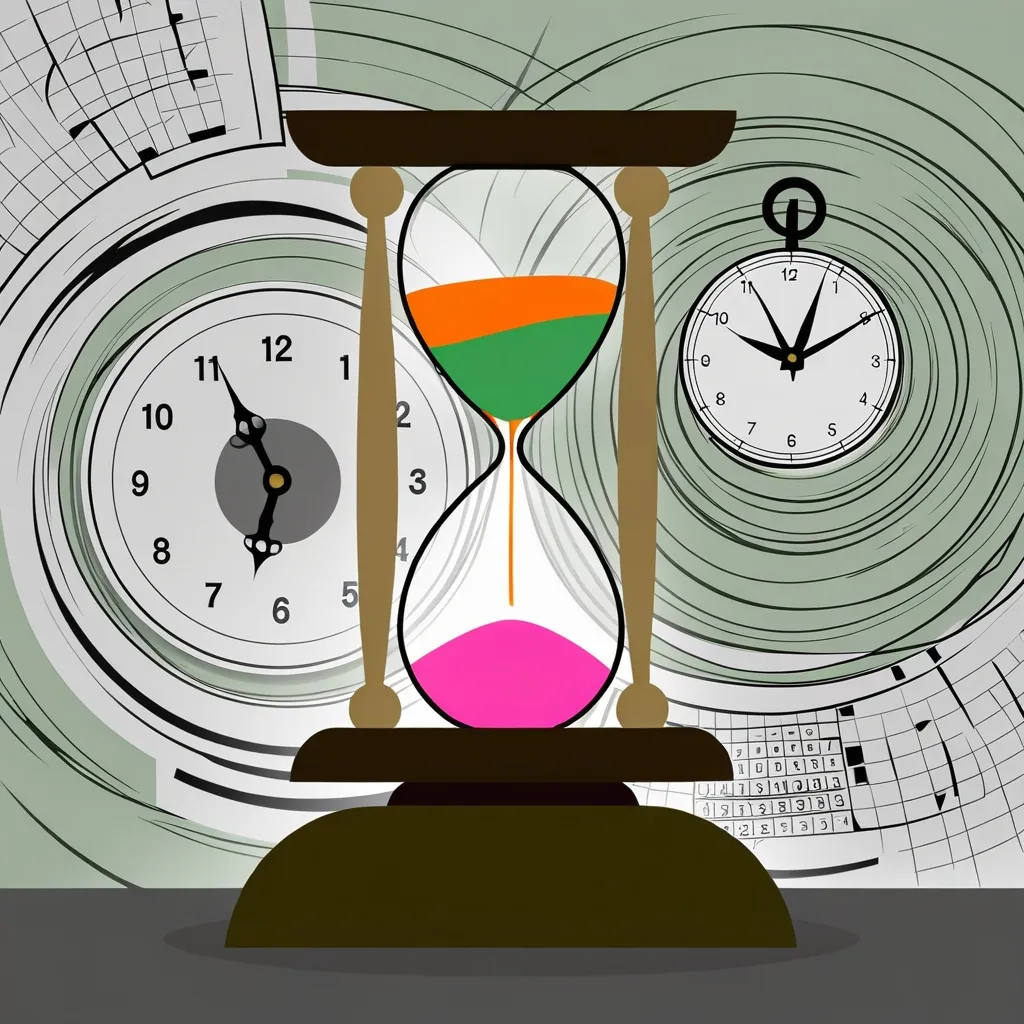Time is our most precious resource, yet it often slips through our fingers like sand. We all have the same 24 hours each day, but some people seem to squeeze so much more out of every minute. What’s their secret? It all comes down to mastering the art of temporal trade-offs.
Think of temporal trade-offs like a game of chess with your daily schedule. Every move you make, every task you choose to tackle, impacts the rest of your day. It’s not about cramming more into each hour, but about making smart choices that align with your goals and priorities.
Let’s break it down. At its core, temporal trade-offs are about balancing different needs over time. It’s like juggling - you can’t keep all the balls in the air at once, so you have to decide which ones to catch and which ones to let drop for a moment.
In our fast-paced world, we often face a tug-of-war between urgent tasks and important ones. You know the drill - that pile of emails screaming for attention versus the big project that could really move the needle for your career. It’s tempting to always go for the quick wins, but sometimes you need to step back and ask yourself: “What really matters in the long run?”
This brings us to a classic conundrum - the exploration-exploitation dilemma. It’s like being at a buffet. Do you stick with the dishes you know you like, or do you try that weird-looking thing in the corner that might be amazing? In life, it’s the same. Do you stick with your tried-and-true routines, or do you shake things up and try new approaches?
The key is finding a balance. Maybe you dedicate one day a week to trying new productivity hacks or work methods. The rest of the time, you stick with what works. This way, you’re not constantly reinventing the wheel, but you’re also not stuck in a rut.
Now, let’s talk about the speed-accuracy trade-off. We’ve all heard the saying “haste makes waste,” right? Well, it’s true, but sometimes speed is exactly what you need. The trick is knowing when to gun it and when to take it slow.
Think about it like cooking. If you’re whipping up a quick sandwich for lunch, you don’t need to measure every ingredient to the gram. But if you’re baking a fancy cake for a wedding, you better take your time and get it right.
In your daily life, this might mean rushing through low-stakes tasks like sorting your inbox, but taking your sweet time on that important presentation for your boss. It’s all about matching your pace to the importance of the task.
Now, here’s where things get really interesting - time resolution and precision. In the world of energy systems, experts grapple with balancing the accuracy of their data against the time it takes to crunch the numbers. But how does this apply to your life?
Well, it’s all about how detailed you want your plans to be. Some people swear by scheduling their day down to the minute. Others prefer a looser approach, breaking their day into morning, afternoon, and evening blocks.
There’s no one-size-fits-all answer here. It depends on your personality and the demands of your life. A surgeon might need a precise schedule, while a creative freelancer might thrive with a more flexible approach. The key is finding what works for you and sticking with it.
So, how do you put all this into practice? Here are some ideas to get you started:
First up, prioritize like your life depends on it. Because in a way, it does. Your time is your life, so spend it wisely. Figure out what really matters to you and make sure those things get prime real estate in your schedule.
Next, try using time blocks. Instead of scheduling every little thing, group similar tasks together. Maybe you have a block for emails, another for meetings, and another for deep work. This gives you structure without being overly rigid.
Don’t forget to balance exploration and exploitation. Set aside some time each week to try new things. Maybe it’s a new productivity app, a different work routine, or even a new hobby. Keep things fresh and you’ll avoid falling into a rut.
Be mindful of the speed-accuracy trade-off. Know when to rush and when to take your time. For those mission-critical tasks, it’s usually better to slow down and get it right.
And remember, your schedule isn’t set in stone. Life is messy and unpredictable. Be ready to review and adjust your plans as needed. Flexibility is key.
Let’s look at some real-life scenarios to bring this home. Say you’re trying to start a morning exercise routine. You might need to trade off some sleep time for workout time. But if you’re not a morning person, you might find that exercising in the evening works better. It’s all about finding what works for you.
Or consider a work project. You might need to decide whether to spend more time on research to ensure accuracy or to move quickly to meet a tight deadline. There’s no universal right answer - it depends on the specifics of your situation.
Even in financial planning, temporal trade-offs come into play. You might need to balance short-term savings goals with long-term investment strategies. Maybe you’re saving aggressively for a house down payment, but also putting some money into your retirement fund. It’s all about finding the right balance for your situation.
Now, let’s get personal. Mastering temporal trade-offs isn’t just about following a set of rules. It’s about understanding yourself and your unique needs and habits.
Pay attention to your energy levels throughout the day. When do you feel most alert and focused? Use those peak times for your most demanding tasks. For me, I’m sharpest in the morning, so that’s when I tackle my toughest work.
Technology can be a great help in managing your time, but don’t go overboard. Sometimes, a simple to-do list on a sticky note can be just as effective as the latest fancy app. Use what works for you.
Here’s a pro tip: always leave some buffer time between tasks. Life has a way of throwing curveballs, and you don’t want your whole day derailed because one meeting ran long.
Remember, optimizing your day isn’t about cramming in more tasks. It’s about making intentional choices about how you use your time. It’s about creating a schedule that not only gets things done but also leaves you feeling fulfilled and balanced.
As you go about implementing these ideas, be patient with yourself. It takes time to find the right balance, and what works for you might change over time. That’s okay. The goal is progress, not perfection.
Think of mastering temporal trade-offs as a lifelong journey. You’re constantly learning, adjusting, and improving. Some days you’ll nail it, other days you’ll fall short. That’s all part of the process.
The beauty of this approach is that it’s not just about being more productive. It’s about creating a life that feels meaningful and balanced. It’s about having time for work, for play, for relationships, and for personal growth.
So, as you go about your day, take a moment to consider the temporal trade-offs you’re making. Are you spending your time in a way that aligns with your values and goals? Are you striking the right balance between urgent tasks and important ones?
Remember, every choice you make about how to spend your time is a trade-off. Make those choices consciously and intentionally. Your future self will thank you for it.
In the end, mastering temporal trade-offs is about more than just managing your time. It’s about managing your life. It’s about making sure that when you look back on your days, weeks, and years, you feel satisfied with how you spent them.
So go ahead, take charge of your time. Make those trade-offs work for you. Your perfectly optimized day is waiting. All you have to do is reach out and grab it.






